|
BMW 5-Series (E60)
Debut: 2003
Maker: BMW
Predecessor: 5-Series E39
|
|
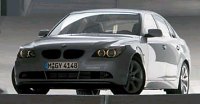 Now
looking back, the last generation 5-series (1995-2003) definitely has a
place in automotive history. Its beauty, high quality, superb handling
and ride made it virtually unbeatable throughout its 8 years life. It
outclassed
the Mercedes E-class launched the following year, ditto all other
competitors,
e.g. Audi A6, Volvo S80, Jaguar S-Type, Lexus GS... so advanced that no
one came close until the arrival of the new Mercedes E-class in 2002,
which
is a whole generation newer. Even so, the new E-class just edged it out
marginally. With
such a
successful past
record, the new 5-series (code name E60) is undoubtedly under huge
pressure.
Even before its launch, most people expect it can easily take the crown
back from Mercedes. The only question is: can it show the same
supremacy
as its predecessor? Now
looking back, the last generation 5-series (1995-2003) definitely has a
place in automotive history. Its beauty, high quality, superb handling
and ride made it virtually unbeatable throughout its 8 years life. It
outclassed
the Mercedes E-class launched the following year, ditto all other
competitors,
e.g. Audi A6, Volvo S80, Jaguar S-Type, Lexus GS... so advanced that no
one came close until the arrival of the new Mercedes E-class in 2002,
which
is a whole generation newer. Even so, the new E-class just edged it out
marginally. With
such a
successful past
record, the new 5-series (code name E60) is undoubtedly under huge
pressure.
Even before its launch, most people expect it can easily take the crown
back from Mercedes. The only question is: can it show the same
supremacy
as its predecessor?
Observing from
outside, the
answer must be negative. Here again, BMW design chief Chris Bangle
continued
his secret mission to ruin BMW’s image. He replaced the old car’s sleek
bodylines with a complex, irregular shape. He ruined the front end
styling
with a pair of strange headlights and an organic interpretation of
double-kidney
grille. He destroyed the rear end beauty by adopting the 7-series’
add-on
boot lid. Sadly, Bangle converted the most stylish executive sedan in
the
world into one of the ugliest - the others are undoubtedly X3, Z4 and
7-series.
I am sure this styling will drive many keen customers away, just like
what
the 7-series is experiencing.
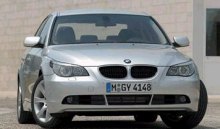 Nevertheless,
mechanically, BMW is still BMW. The 5-series continues its persistence
in rear-wheel-drive, straight-6 engines, front MacPherson strut and
rear
Z-axle suspensions. Size-wise, it grows a little to improve cabin
space.
Weight-wise, it undercuts its predecessor, thanks to a revolutionary
aluminum-steel
hybrid chassis. The main chassis is conventional steel monocoque, but
from
the firewall forward, the whole front structure is made of aluminum -
chassis
frames, suspension sub-frames, fenders, bonnet, most of the
suspensions,
brake calipers... this help it cutting 65kg from the old 5-series and,
more importantly, achieving 50:50 weight distribution. If the whole
chassis
were made of aluminum, it would have neither balanced that well nor
made
as much profit. Nevertheless,
mechanically, BMW is still BMW. The 5-series continues its persistence
in rear-wheel-drive, straight-6 engines, front MacPherson strut and
rear
Z-axle suspensions. Size-wise, it grows a little to improve cabin
space.
Weight-wise, it undercuts its predecessor, thanks to a revolutionary
aluminum-steel
hybrid chassis. The main chassis is conventional steel monocoque, but
from
the firewall forward, the whole front structure is made of aluminum -
chassis
frames, suspension sub-frames, fenders, bonnet, most of the
suspensions,
brake calipers... this help it cutting 65kg from the old 5-series and,
more importantly, achieving 50:50 weight distribution. If the whole
chassis
were made of aluminum, it would have neither balanced that well nor
made
as much profit.
Of course, all
engines are
made of essentially aluminum. In fact, all are familiar - BMW often
launches
new cars with existing engines and then new engines at mid-life
makeover.
In petrol side, there are 3 straight-six (170hp 2.2-litre for 520i,
192hp
2.5-litre for 525i and 231hp 3.0-litre for 530i) and a Valvetronic V8
(328hp
4.4-litre for 545i). In the diesel side, it offers as much as 4
common-rail
injection turbo engines to cope with strong demand in Europe - 150hp
2.0-litre
four for 520d, 184hp 2.5-litre straight-six for 525d, 218hp 3.0-litre
straight-six
for 530d and 258hp 3.9-litre V8 for 540d.
 Every
BMW engine is a masterpiece, but we always prefer the petrol
straight-six.
Here, pick of the range is 530i. We used to praise the power, silkiness
and willingness of the 3.0 engine. It is simply the best mass
production
6-cylinder engine in the world. In the 65kg-lighter new 530i, with one
more gear ratio (no matter from the slick 6-speed manual gearbox or the
super-smooth 6-speed ZF automatic), it takes just 6.6 seconds to
accelerate
from zero to 60mph, easily outperforms the last 5-series and simply
everybody
else in the 3-litre class. Of course, 545i is even stronger (0-60mph
takes
5.5 sec), but it seems that 530i is the best balance between
performance,
refinement and cost. Every
BMW engine is a masterpiece, but we always prefer the petrol
straight-six.
Here, pick of the range is 530i. We used to praise the power, silkiness
and willingness of the 3.0 engine. It is simply the best mass
production
6-cylinder engine in the world. In the 65kg-lighter new 530i, with one
more gear ratio (no matter from the slick 6-speed manual gearbox or the
super-smooth 6-speed ZF automatic), it takes just 6.6 seconds to
accelerate
from zero to 60mph, easily outperforms the last 5-series and simply
everybody
else in the 3-litre class. Of course, 545i is even stronger (0-60mph
takes
5.5 sec), but it seems that 530i is the best balance between
performance,
refinement and cost.
So, the
5-series
continues
its lead in powertrain and performance. What about handling and
ride?
Talk
straight,
this is the
best handling executive car in the world, if not the best riding.
Mercedes
E-class (with its adaptive springing and damping) still has a small
advantage
in ride quality, but the new 5-series is not far away. On the other
hand,
the BMW shines in body control and eagerness to turn into corners, the
former must thanks to the "Dynamic Drive" active anti-roll bar (from
the
7-series) while the latter is the benefited from the lightweight front
end.
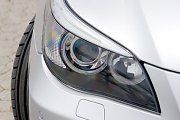 However,
the most brilliant thing is the new Active Front Steering (AFS). BMW
claims
it is the world’s first steering rack which can vary the steering ratio
according to needs. (This is not true, because 3 years ago Honda
already
introduced a variable gear ratio steering called VGS into the S2000
Type
V, although its function is not as versatile as the BMW’s) AFS can vary
the steering ratio from as much as 5.0 turns lock to lock to a
super-quick
1.7 turns. Electronic brain will decide the ratio according to speed
and
other factors, such as understeer / oversteer. Basically, at low speed,
or even parking speed, the steering will be quickened so that you can
turn
the car quickly. The higher the speed, the slower the steering becomes
to aid stability and confidence. But the "active" steering doesn’t stop
there. It also works with the stability control to cure understeer /
oversteer.
If the car is understeering, it will turn the steering more than the
driver
does to neutralize it. How can it do that? AFS employs an electric
motor
to do so. The steering rack is originally geared to deliver 3.0 turns
lock
to lock. When quicker ratio is needed, the electric motor rotates to
increase
steering speed. When slower ratio is needed, the motor rotates in
opposite
direction to reduce steering speed. However,
the most brilliant thing is the new Active Front Steering (AFS). BMW
claims
it is the world’s first steering rack which can vary the steering ratio
according to needs. (This is not true, because 3 years ago Honda
already
introduced a variable gear ratio steering called VGS into the S2000
Type
V, although its function is not as versatile as the BMW’s) AFS can vary
the steering ratio from as much as 5.0 turns lock to lock to a
super-quick
1.7 turns. Electronic brain will decide the ratio according to speed
and
other factors, such as understeer / oversteer. Basically, at low speed,
or even parking speed, the steering will be quickened so that you can
turn
the car quickly. The higher the speed, the slower the steering becomes
to aid stability and confidence. But the "active" steering doesn’t stop
there. It also works with the stability control to cure understeer /
oversteer.
If the car is understeering, it will turn the steering more than the
driver
does to neutralize it. How can it do that? AFS employs an electric
motor
to do so. The steering rack is originally geared to deliver 3.0 turns
lock
to lock. When quicker ratio is needed, the electric motor rotates to
increase
steering speed. When slower ratio is needed, the motor rotates in
opposite
direction to reduce steering speed.
That’s why
some
hardcore
motor journalists are puzzled: who is the driver? who steer the car? in
fact, a few years ago stability control (ESP etc.) also raised the same
questions. As technology progress, we can expect more and more
intervention
from computers. Just ask who brake the Mercedes SL500, who launch the
Ferrari
Enzo (or Mike’s F2003-GA).... no matter you like or not, you have to
admit
AFS really transformed the 5-series - in country roads, it sharpen the
steering response so much. On motorway, it eliminates nervousness. Once
you get used to it, you will never come back to the world of passive
steering.
In short, the
5-series is
fun to drive. The only let down in its dynamic behaviour is the
handling
at the limit - we are talking about the last 10% of its performance
envelop.
While the old car let drivers more control, the new car deliberately
programmed
more understeer into the chassis (probably via the active steering and
stability control) in the name of safety. That is quite disappointing
for
a company used to understand so well what keen drivers love.
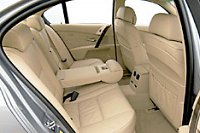 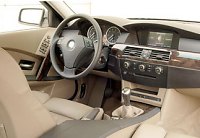 The
same goes for the interior design. Gone is the driver-oriented console,
replaced by an odd twin-binnacles design similar to the 7-series’.
Again,
this is Chris Bangle’s job. The door panels look ugly, some plastic
looks
cheap, some woods look like plastic.... luckily, rear passengers get
more
legroom. Now 5 six-footers can sit comfortably in the 5-series. The
same goes for the interior design. Gone is the driver-oriented console,
replaced by an odd twin-binnacles design similar to the 7-series’.
Again,
this is Chris Bangle’s job. The door panels look ugly, some plastic
looks
cheap, some woods look like plastic.... luckily, rear passengers get
more
legroom. Now 5 six-footers can sit comfortably in the 5-series.
Answer our
question: is it
better than the E-class? yes, but not convincing enough. Does it show
the
same supremacy as the old 5-series? no. This car is far from perfect.
It
looks ugly inside and outside. It lacks attention to details. It does
not
involve its driver as much as the last one do. It is the best of this
generation,
but it won’t hold a place in automotive history book, unlike its
predecessor.
|
| The
above report was last updated on 31 July
2003. All Rights Reserved. |
535d: the diesel sports sedan
|
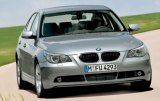 I
rarely write an article exclusively for a diesel car, unless there is
any
technological breakthrough in its diesel power. BMW 535d is one of
them.
It introduces a new variable twin-turbocharging technology developed by
BorgWarner (which owns German turbo expert KKK). This technology helps
it to attain a specific output of 90 horsepower per litre, a figure
never
heard for production diesel engines. For comparison, the "ordinary" BMW
530d produces 218 horsepower and 369 lbft of torque, therefore
translating
to 73 hp / litre. The 535d uses the same 2993cc 24-valve inline-6 as
530d
(despite of its name "535"), but it produces 272 hp and 413 lbft. It
drinks
a little more fuel, but still achieves a respectable 35.3mpg combined
cycle.
How can it do that? I
rarely write an article exclusively for a diesel car, unless there is
any
technological breakthrough in its diesel power. BMW 535d is one of
them.
It introduces a new variable twin-turbocharging technology developed by
BorgWarner (which owns German turbo expert KKK). This technology helps
it to attain a specific output of 90 horsepower per litre, a figure
never
heard for production diesel engines. For comparison, the "ordinary" BMW
530d produces 218 horsepower and 369 lbft of torque, therefore
translating
to 73 hp / litre. The 535d uses the same 2993cc 24-valve inline-6 as
530d
(despite of its name "535"), but it produces 272 hp and 413 lbft. It
drinks
a little more fuel, but still achieves a respectable 35.3mpg combined
cycle.
How can it do that?
The BorgWarner
variable twin-turbo
system is interesting. Regular turbocharging system has one turbo thus
its size is a compromise between low-end response (which requires
smaller
and lighter turbine) and high-rev power (which requires big turbine).
More
sophisticated systems use twin-turbocharger, usually connected in
parallel
and operate simultaneously. But this is still a compromise between low
and high rev. In contrast, BorgWarner’s system employs a pair of
turbochargers
of different sizes - a small turbo takes care of low rev operation and
a big turbo realizes maximum boost at high rev. They are connected in
series
but the intake air can by-pass the big turbo through an alternative
path.
The exhaust gas from 6 combustion chambers are distributed to the 2
turbos
by means of a control valve. That means exhaust gas to each turbo can
be
varied according to rev.
This
seems
complicated. Let
us explain below:
- From idle to
1500 rpm,
the control valve directs most exhaust gas to the small turbo. Because
of its low inertia it revs up almost instantly. Fresh air by-pass the
big
turbo and is compressed by the small turbo. At 1500 rpm, the engine
generates
391 lbft of torque.
- From 1500
rpm
to 2500 rpm,
the big turbo starts taking over. The higher the rev, the more exhaust
gas is distributed to the big turbo. The boost from the big turbo is
multiplied
by the small turbo. The resultant boost pressure rises according to rev
and therefore produces higher power. The transition is smooth and
unaware
by the driver. At 2000 rpm, the engine generates maximum torque of 413
lbft.
- Above 2500
rpm,
almost
all exhaust gas is directed to the big turbo to provide maximum boost.
At 4400 rpm, the engine produces the maximum power 272 hp. Thanks to
the
big turbo, the engine can rev to 5000 rpm, higher than most other turbo
diesel engines.
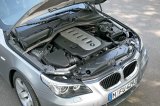 With
the variable twin-turbocharging technology, 535d not only sets a new
record
for power efficiency, but it also replaces Audi A8 4.0 TDI as the
world’s
fastest diesel car. It accelerates from rest to 60 mph in a sports
sedan-like
6.2 seconds. (Top speed is again limited to 155 mph) That’s also faster
than the V8 Mercedes E400 CDI and Volkswagen’s monster V10-powered
Phaeton
5.0 TDI. The six-cylinder BMW is really a giant killer! With
the variable twin-turbocharging technology, 535d not only sets a new
record
for power efficiency, but it also replaces Audi A8 4.0 TDI as the
world’s
fastest diesel car. It accelerates from rest to 60 mph in a sports
sedan-like
6.2 seconds. (Top speed is again limited to 155 mph) That’s also faster
than the V8 Mercedes E400 CDI and Volkswagen’s monster V10-powered
Phaeton
5.0 TDI. The six-cylinder BMW is really a giant killer!
However, as
the
technology
is not exclusively developed for BMW, I expect it to be spread to other
car makers in the near future. Next year, Opel will use this technology
in a diesel-powered Vectra OPC. It will lift the 1.9-litre engine to
212hp,
breaking the 100hp / litre barrier for the first time. |
| The
above report was last updated on 31 Jul
2004. All Rights Reserved. |
M5
|
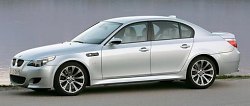 M5
is always the definitive BMW, representing the Munich company’s
expertise
in sports saloons. Throughout the years, its combination of
performance,
handling and driver involvement remained unrivalled. The early M5 had
its
straight-6 engine developed from the M1. Then in 1998 it was upgraded
to
a 5.0 V8 capable of delivering 400 horsepower. Performance took a big
leap,
but its torquey, lazy character was slightly out of sync with the
previous
M-power. Recently, Mercedes E55 AMG and Audi RS6 lifted the power game
with forced induction V8s and therefore beat M5 in performance. Though
the BMW remains the overall winner, thanks to its superb chassis, its
class-leader
status was shaking. BMW knew it must find a better engine to power the
new generation M5. M5
is always the definitive BMW, representing the Munich company’s
expertise
in sports saloons. Throughout the years, its combination of
performance,
handling and driver involvement remained unrivalled. The early M5 had
its
straight-6 engine developed from the M1. Then in 1998 it was upgraded
to
a 5.0 V8 capable of delivering 400 horsepower. Performance took a big
leap,
but its torquey, lazy character was slightly out of sync with the
previous
M-power. Recently, Mercedes E55 AMG and Audi RS6 lifted the power game
with forced induction V8s and therefore beat M5 in performance. Though
the BMW remains the overall winner, thanks to its superb chassis, its
class-leader
status was shaking. BMW knew it must find a better engine to power the
new generation M5.
The new M5
shares
all the
good stuffs with the E60 5-Series, such as the aluminum front chassis
to
achieve near-perfect balance, but without the troublesome stuffs - the
controversial AFS active steering and Dynamic Drive active anti-roll
bar.
BMW believes for the benefit of pure driver control the M5 should rely
on classic setup rather than too much artificial driving aids. A
super-quick
(2.4 turn from lock to lock) steering rack, stiff suspension setup,
3-level
adaptive damping, wide rubbers and big brakes are all it needs in
chassis
modifications.
Under the
aluminum bonnet
is a new V10. It displaces the same 5.0 litres as the previous V8, but
it generates an astonishing 507 horsepower and 383 lbft of torque.
That’s
107 hp and 14 lbft up from the V8, without ever using turbo or
supercharger.
Now the M5 overwhelms E55 by 30 horsepower and RS6 by nearly 60 hp. It
also weighs less - 5 kg lighter than E55 and 85 kg less than RS6.
Although
its rivals deliver considerably more torque, the BMW’s torque goes
through
a 7-speed SMG manual gearbox, versus its rivals’ 5-speed automatic,
should
be more than compensated.
According to
BMW,
the new
M5 accelerates from 0 to 60 mph in 4.6 seconds and 124 mph in 14.9
seconds,
the latter is 1.6 seconds quicker than the new Porsche 911 Carrera S !
also according to BMW, it laps Nurburgring in approximately 8 minutes.
As for top speed, if not electronic limited at 155mph, BMW claims it
could
have topped 205 mph !!
High-revving
V10 and 7-speed
SMG
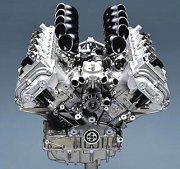 The
90-degree V10 is the work of BMW’s Motorsport department. It is not
related
to the Williams F1 engine in any way, but the technology it uses is
undoubtedly
state-of-the-art. The fact that it beats Lamborghini’s 5.0 V10 in both
power and torque is not by luck. The
90-degree V10 is the work of BMW’s Motorsport department. It is not
related
to the Williams F1 engine in any way, but the technology it uses is
undoubtedly
state-of-the-art. The fact that it beats Lamborghini’s 5.0 V10 in both
power and torque is not by luck.
The M-power
V10
has power-biased
oversquared combustion chambers, with 92 mm bore versus 75.2 mm stroke.
It displaces 4999 cc. Thanks to a sophisticated anti-knock control, it
can run a super-high compression ratio at 12.0:1, maximizing burning
efficiency.
Like other BMW engines, Bi-Vanos variable valve timing is used at all
four
camshafts. Besides, by using lightweight tappets, valves and valve
springs,
the moving mass of valve gears is reduced by 17.5% compare with the
previous
M5. This allows the engine to rev up to 8250 rpm, versus 7000 rpm of
the
outgoing 5-litre V8.
At
7750 rpm, the
V10 produces
507 horsepower. Maximum torque of 383 lbft is not reached until 6100
rpm,
but from 3500 rpm there is at least 80% of the max torque
available.
The
V10 weighs
240kg, almost
identical to the outgoing V8. This cannot match Porsche Carrera GT’s
V10
however, which weighs only 214kg despite of its higher capacity and
power.
Predictably, the BMW V10 employs all-aluminum construction (heads,
block
and pistons), Nikasil cylinder liners, forged crankshaft and connecting
rods. But to provide higher reliability and NVH suppression, the
crankcase
employs bedplate with integral cast iron inserts to hold the crankshaft
bearings tight.
The
V10 runs
12.0:1 compression
yet complies with EU4 emission regulation, thanks to a sophisticated
engine
management system and ionic current knock control. Ordinary engines
have
their knock sensors located outside the cylinder, but this engine
incorporate
sensors at spark plugs and measure the ionization degree of air / fuel
mixture inside the combustion chambers to determine whether knock is
coming.
This measurement is more precise thus the compression can be set closer
to the knock limit. Besides, the MSS65 engine management system takes
signals
from more sensors of various kinds and its processing power is 8 times
that of the MSS54 used in M3.
The
M5 engine is
high revving
and powerful, but its lack of torque means it needs a close ratio
gearbox
to fight against its turbocharged or supercharged rivals. Therefore BMW
developed the world's first series production 7-speed sequential manual
gearbox for it. With 2 ratios more than rival's 5-speed automatic, and
a shift mechanism 20% faster than the M3's SMG-II, the third generation
SMG should enable the V10 to pick up rev quickly after each gearchange.
The result is of course quicker acceleration.
On the Road
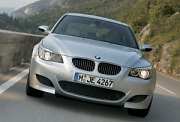 Unsurprisingly,
the V10 is a marvelous engine, being smooth, linear and responsive. At
the lower end of the spectrum, it pulls cleanly from 1500 rpm at 7th
gear.
At the other end, it revs eagerly towards 8000 rpm. The noise hardens
as
rev picks up, eventually approaching the quality of F1 engines, which
is
exciting. Unsurprisingly,
the V10 is a marvelous engine, being smooth, linear and responsive. At
the lower end of the spectrum, it pulls cleanly from 1500 rpm at 7th
gear.
At the other end, it revs eagerly towards 8000 rpm. The noise hardens
as
rev picks up, eventually approaching the quality of F1 engines, which
is
exciting.
The
power?
terrific. So strong
that BMW has to offer a P400 mode, whose engine mapping limits output
to
400 hp, which lengthens the time taken for 0-60 mph from 4.6 to 5.3
seconds
(still very fast indeed). This is the mode you need for daily safe
driving,
so BMW set it as default. If you want more power, flick the switch to
P500
and it unleashes the 507 horsepower. Initially, you might find Mercedes
E55 is able to keep up with the M5, thanks to its superior mid-range
torque,
but from 100 mph the BMW starts pulling away. The higher the speed, the
bigger advantage the BMW has. In the sports saloon world only S65 AMG
can
be faster.
But S65 can
never
be so controllable,
neither are E55 and RS6. The M5 displays terrific body control and
decent
agility for such a heavy car. Its fine balance and linear power allows
the driver to exploit classic power slide in corners, even more
controllable
than the old M5 in this respect. Its Servotronic steering is quick,
feelsome
and meaty, much more connected to the driver than its Mercedes and Audi
counterparts. Undoubtedly, this is a great driver’s car.
Despite that,
the
M5 no longer
tops our rating for desirability, because the new Maserati Quattroporte
provides even sweeter steering and chassis balance, and subjectively, a
lovely styling and tasteful interior hit right on the weakness of M5.
However
great the M5 is, it still shares the strange look and low rent interior
of the E60 5-Series. Nevertheless, Maserati Quattroporte rides poorly
and
produces at least one hundred horsepower less than the M5, so it is not
yet capable to challenge the M5 as the world’s best sports saloon.
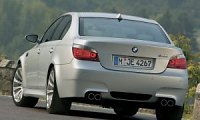 One
thing I don’t like the new M5 is how complicated it becomes. Despite
getting
rid of AFS and Dynamic Drive, it still employs too much electronic
driver
aids. The suspension has 3 levels of damper stiffness for choose. The
SMG
gearbox has 11 modes (6 for manual, 5 for auto), plus a launch mode
like
Ferrari Enzo and F430. To find the right setting is sometimes playful
and
sometimes annoying. The M5 never rides supplely - not in the league of
E55. In the softest suspension setting it is acceptably smooth for
everyday
driving, but simultaneously body control is less good. Choose stiffer
settings
and you sacrifice ride quality for handling. You can’t have the cake
and
eat it. One
thing I don’t like the new M5 is how complicated it becomes. Despite
getting
rid of AFS and Dynamic Drive, it still employs too much electronic
driver
aids. The suspension has 3 levels of damper stiffness for choose. The
SMG
gearbox has 11 modes (6 for manual, 5 for auto), plus a launch mode
like
Ferrari Enzo and F430. To find the right setting is sometimes playful
and
sometimes annoying. The M5 never rides supplely - not in the league of
E55. In the softest suspension setting it is acceptably smooth for
everyday
driving, but simultaneously body control is less good. Choose stiffer
settings
and you sacrifice ride quality for handling. You can’t have the cake
and
eat it.
The same story
goes for the
SMG gearbox. The slowest setting is smoothest, the quickest one is most
brutal, somewhat out of character with the engine. You may say it just
give you more options, but sometimes too much choices could causes
headache
and makes the car characterless.
Not
everyone
share the above
opinion, but they must agree that the biggest disappointment of M5 is
braking.
It employs very large discs - 374mm front, 370mm rear - but the
twin-pot
and single-pot calipers fail to provide sufficient pad area. That means
while initial braking power is strong, after a lap or two in racing
tracks
the braking fades quickly. This reminds me the early M-cars, as they
were
also fast cars with relatively weak brakes.
That
said, the
great engine,
performance and handling are already enough to put M5 back on the top
spot
of sports saloon. It is just not as perfect as we wish. |
| The
above report was last updated on 23 Oct
2004. All Rights Reserved. |
|
|